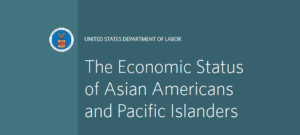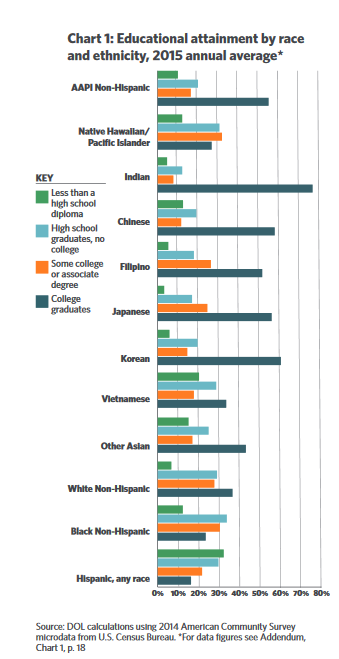 By Louis Chan
By Louis Chan
AsAmNews National Correspondent
A new report on the economic status of Asian Americans and Pacific Islanders focuses on the importance of looking at education when telling the Asian American story.
Asian Americans and Pacific Islanders have the lowest unemployment rate than any other ethnic group in the country. They also have the highest educational attainment in the country (see Chart 1).

The report concludes the two are interconnected. Higher educational achievement leads to higher employment.
Some of these disparities can be explained by the fact that the groups also differ on many other factors related to economic outcomes, including education, age, gender, citizenship status, state of residence, and more. Consider education. Chart 1 shows that the AAPI community has, on average, higher educational attainment than other groups. It is also
true that, for all racial and ethnic groups, workers with higher levels of education tend to have lower unemployment rates. Thus, the fact that the AAPI community has higher levels of education explains part of their lower unemployment rates. —Dept of Labor Economic Status of Asian Americans and Pacific Islanders
Troubling however is the long-term unemployment rate AAPIs. The community has the second highest share of unemployed workers who are long-term unemployed (30.2 percent), trailing only the Black Non-Hispanic community (34.7 percent).
Also troubling is that AAPIs have higher unemployment rates when compared to those with similar educational achievements. When groups with similar educational levels are compared, this is what the report found:
Indians have higher unemployment rates than White Non-Hispanic workers – as do Koreans, Other Asians, and Native Hawaiian and Other Pacific Islanders – while Chinese workers have unemployment rates that are statistically indistinguishable from White Non-Hispanic workers. It is only among Japanese workers that the unemployment rate remains lower than that of White Non-Hispanics—Dept of Labor Economic Status of Asian Americans and Pacific Islanders
The same can be said with earnings. Asian Americans and Pacific Islanders earn more than other groups, but when you compare AAPIs with those with similar educational backgrounds, AAPIs earn less. Table 6 breaks down earnings by gender, race and ethnicity.
The report concludes:
AAPI workers earn significantly more than White Non-Hispanic workers, AAPI workers in fact earn less than White Non-Hispanic workers who have similar characteristics and do similar jobs. In particular, in raw comparisons, Indians, Chinese, Filipinos, Japanese, and Koreans all earn more than White Non-Hispanic workers. However, after controlling for observable differences, the magnitude of the differences is substantially diminished across the board, and in the case of
Filipino workers, completely reversed. On the other hand, in raw comparisons, Vietnamese, Other Asians, and Native Hawaiian and Other Pacific Islanders have significantly lower earnings than White Non-Hispanic workers, but the magnitudes of those differences are also diminished when comparing workers of similar characteristics. This type of analysis not only indicates that a number of factors contribute to the raw earnings differences seen between AAPIs and other races and ethnicities, but also helps further illustrate the importance of disaggregating data by AAPI subgroup. While the final set of regressions show AAPIs’ overall earnings being statistically significantly less than the earnings of comparable White Non-Hispanics, this is not the case for all subgroups–Dept of Labor Economic Status of Asian Americans and Pacific Islanders
Left unsaid in the report is an analysis of why the educational achievement of Asian Americans in higher. It’s generally accepted that immigration is the main driver behind that. Those with higher educational achievements who have job skills in demand by employers are more likely to obtain visas to enter the country. 74 percent of all Asians in the United States are foreign born, according to PEW study in 2013.
You can read the full Department of Labor report here.
AsAmNews is an all-volunteer effort of dedicated staff and interns. You can show your support by liking our Facebook page at www.facebook.com/asamnews, following us on Twitter, sharing our stories, interning or joining our staff.
